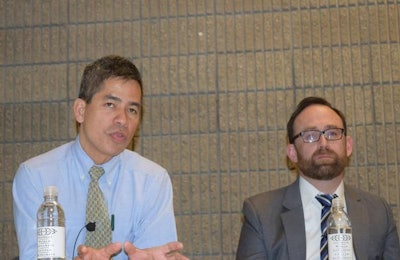
There is no magic formula or product that will make removing antibiotics from poultry production easy. It’s a process, and one that requires attention to detail, more communication between growers and flock managers, better hatchery management, a change in culture, plus other subtle changes. Those factors were discussed by a panel of veterinarians deeply involved in the process on January 27 at IPPE 2016.
The discussion, presented by WATT Global Media and sponsored by DuPont Animal Nutrition, included Dr. Bruce Stewart-Brown, vice president of food safety and quality, Perdue Farms; Dr. Brian Wooming, senior staff veterinarian, Cargill Turkey Products; Dr. Jeff Courtney, director of veterinary services for Pilgrim’s Pride and Dr. Alastair Thomas, DFM business manager, DuPont Animal Nutrition. The program was presented by WATT Global Media and sponsored by DuPont Animal Nutrition.
A common theme of the discussion was that removing antibiotics forces you improve the management of the flocks and the process.
“If you monitor antibiotic use, you find farms that are using more antibiotics than other farms. When you start pulling antibiotics, differences start showing up between farms and even between houses,” said Stewart-Brown. “Once you start to build the data, you find the problem houses or problem farms, you can then find the problems.”
Finding those problems and solving them often benefits multiple areas of the operation.
Dr. Wooming of Cargill said he sees benefits in three areas from the drive to reduce antibiotic use. “Two of these relate to the culture. First, the service staff is much more willing to adopt alternatives to antibiotics and use them sooner. Second, there is more care taken in deciding when to use antibiotics. The third thing is, you start to see certain farms or service guys that stand out. There is a lot more attention to resolving chronic, multi-factoral problems now that we’ve identified them.”
The presentation lasted one hour, with a half hour of questions.
See all the latest IPPE news.

















